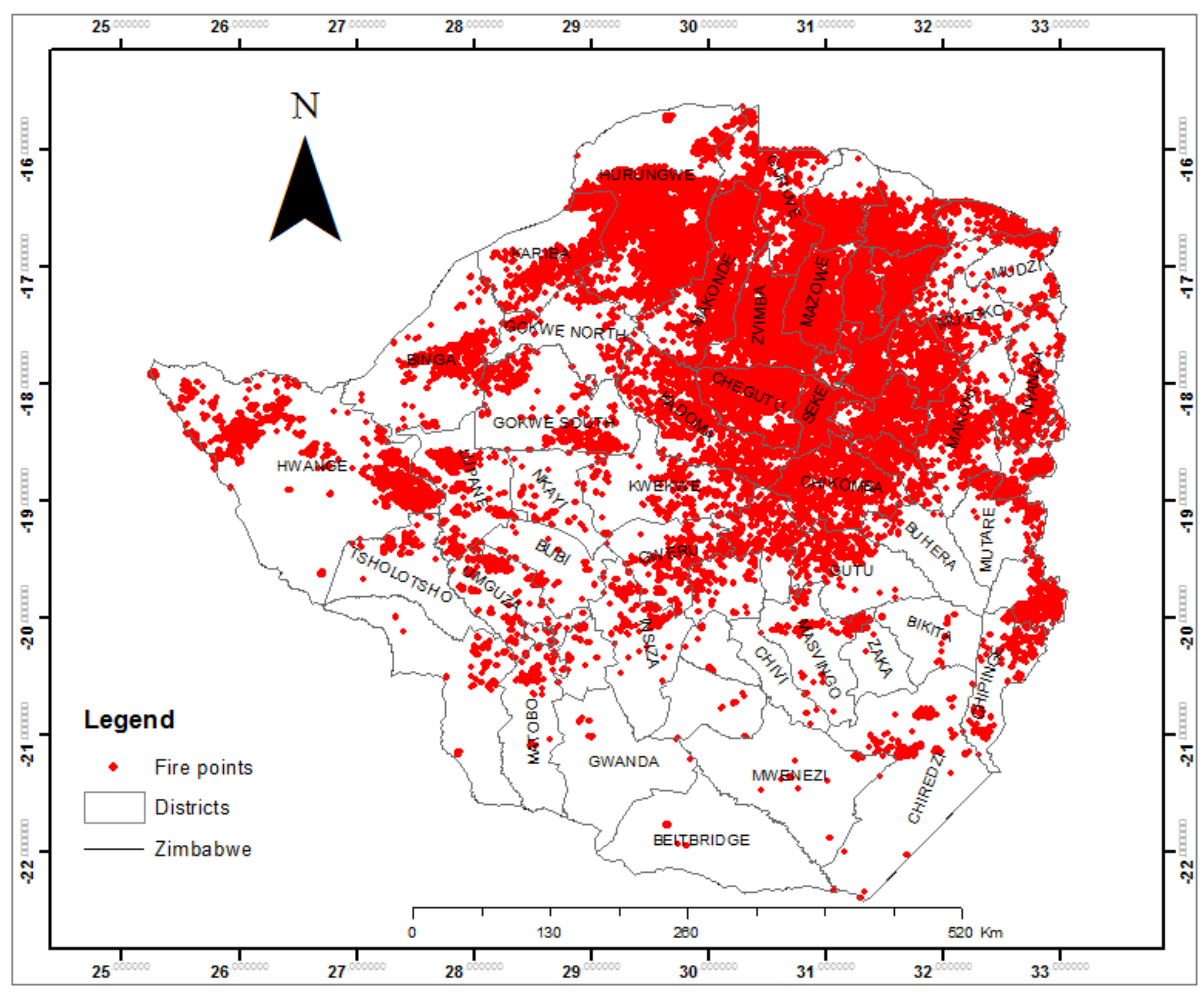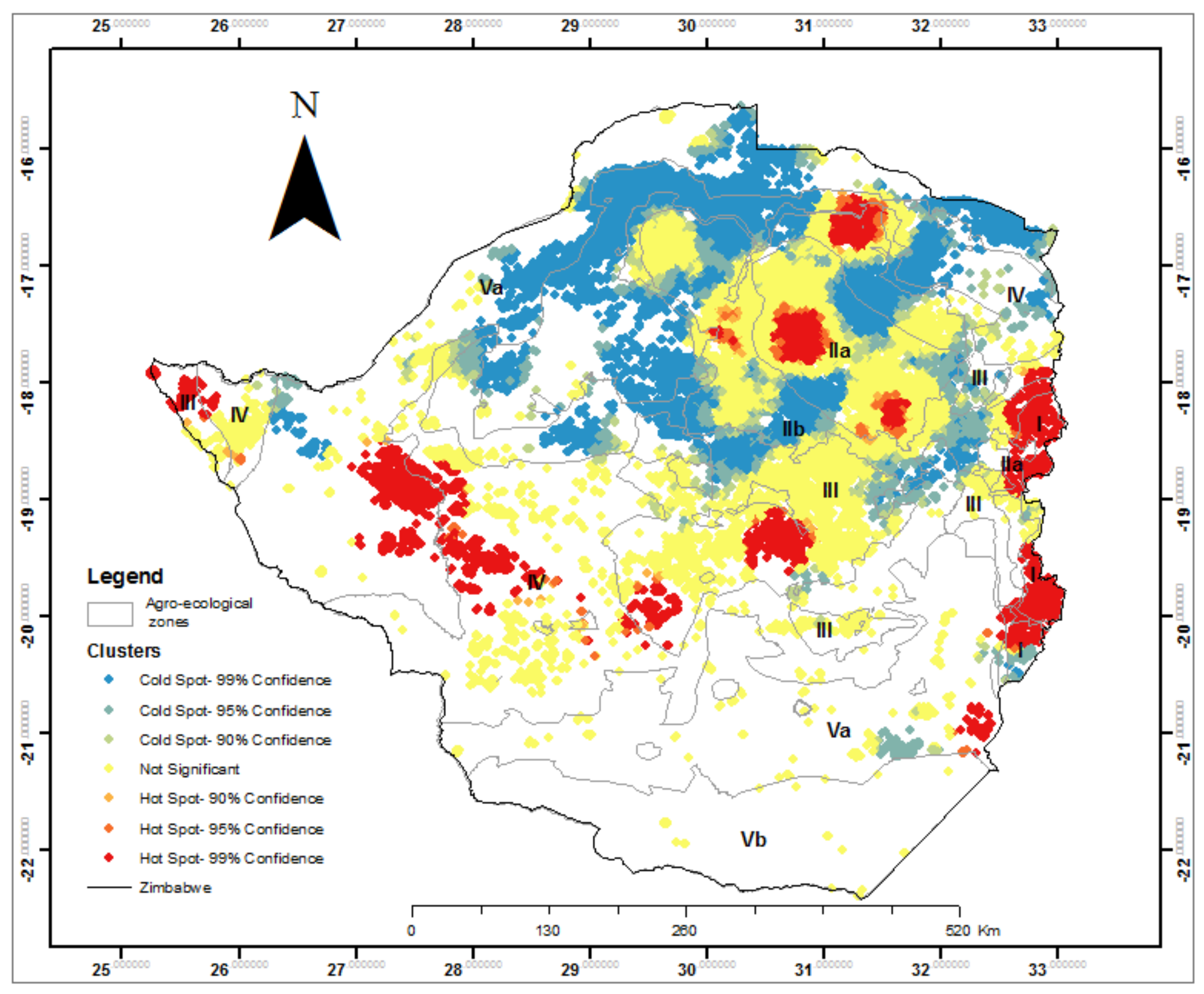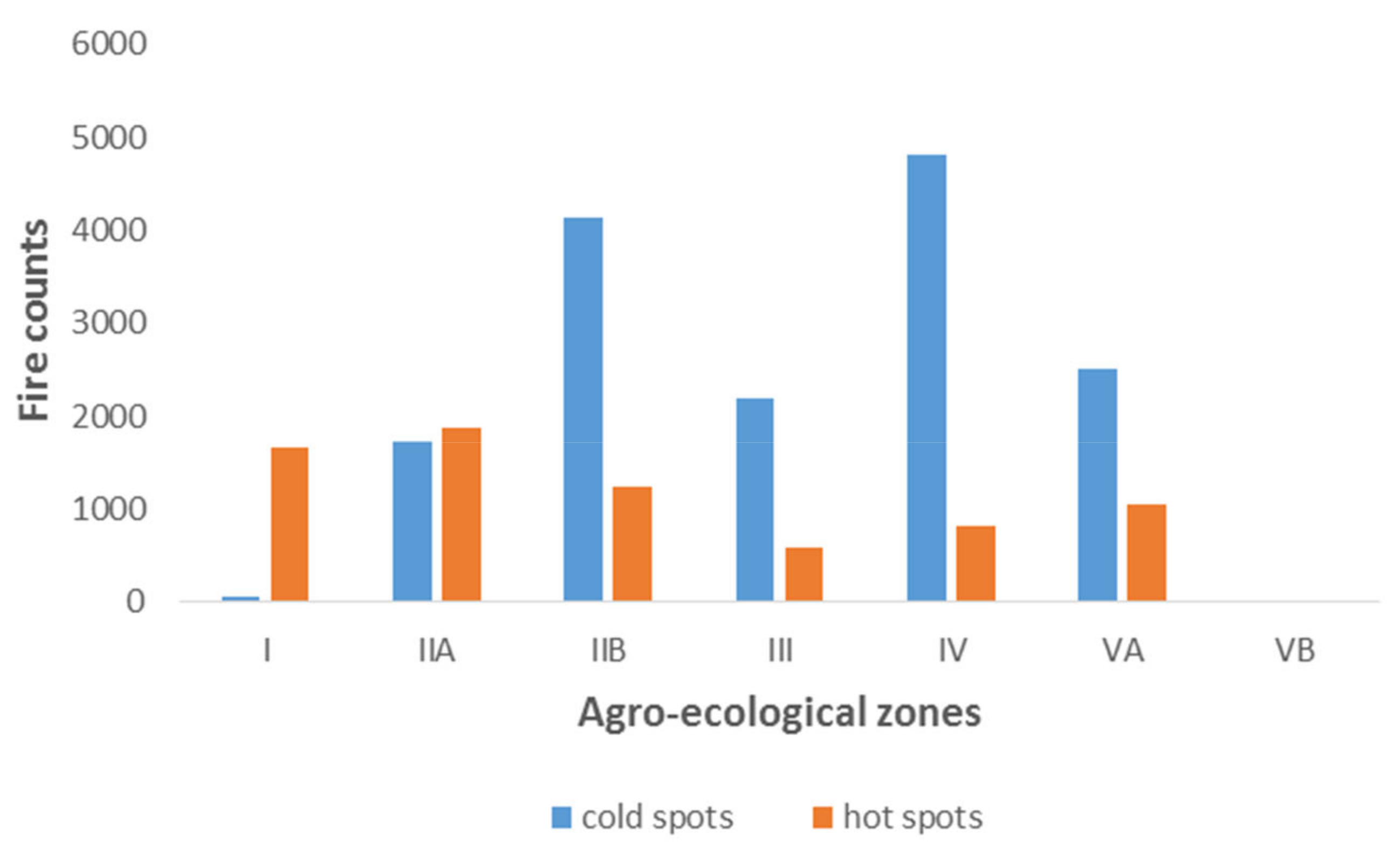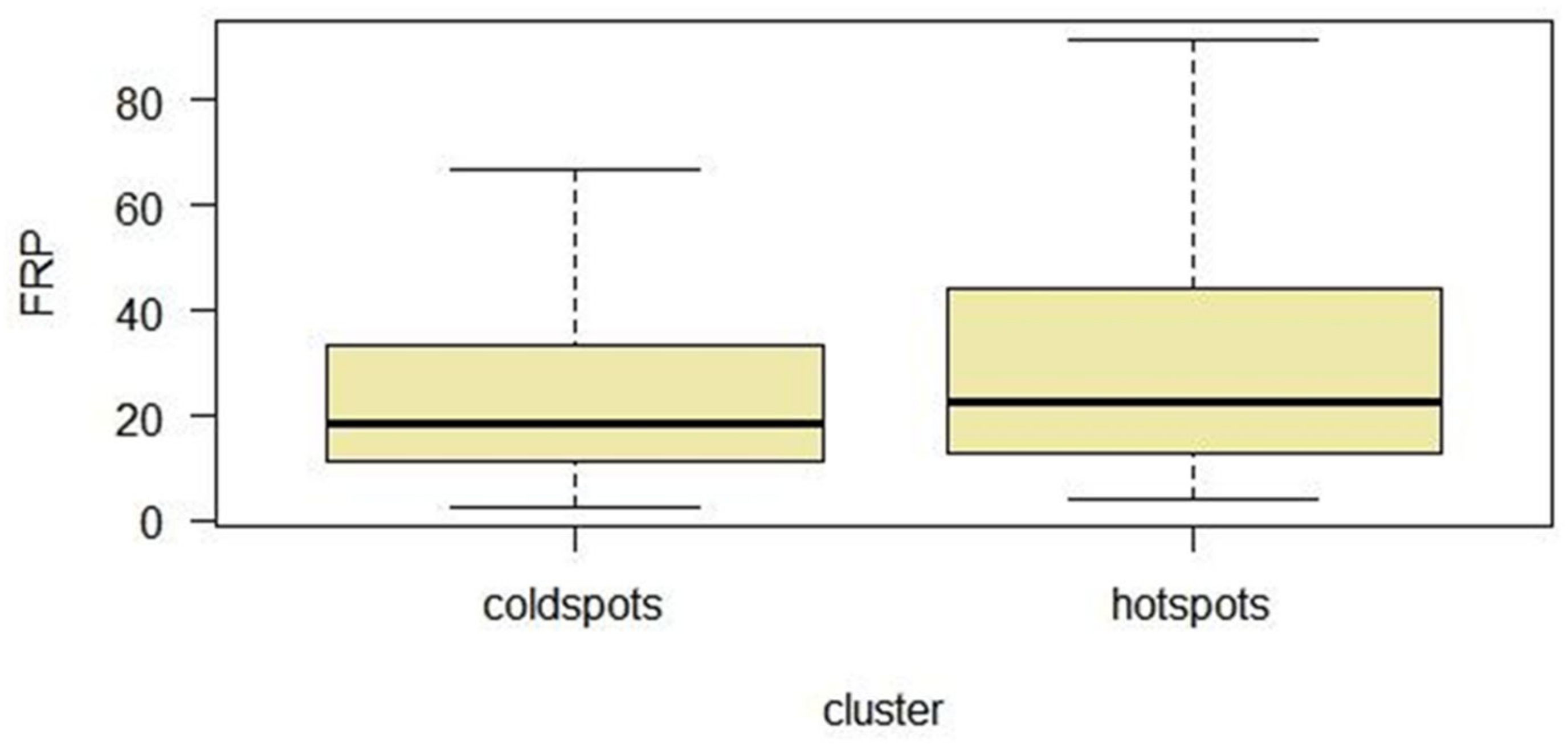Spatial Clustering of Vegetation Fire Intensity Using MODIS Satellite Data
Abstract
1. Introduction
2. Materials and Methods
2.1. Study Area
2.2. Satellite Data
2.3. Pre-Processing of Data
2.4. Data Analysis
2.4.1. Spatial Clustering of Fire Intensity
2.4.2. Analysis of Fire Intensity within Clusters
2.4.3. Correlation of Fire Intensity Clusters with Topographic Factors
2.4.4. Association between Fire Intensity and Vegetation Cover Types
2.4.5. Association between Fire Intensity and Agroecological Zones
3. Results
3.1. Spatial Distribution of Active Fires
3.2. Spatial Distribution of fire Intensity
3.3. Association between Fire Intensity and Topography and Vegetation
3.3.1. Correlation of Fire Intensity with Topographic Variables
3.3.2. Association between Fire Intensity and Vegetation Type
4. Discussion
5. Conclusions
Author Contributions
Funding
Data Availability Statement
Conflicts of Interest
References
- Andela, N.; van der Werf, G.R. Recent Trends in African Fires Driven by Cropland Expansion and El Niño to La Niña Transition. Nat. Clim. Change 2014, 4, 791–795. [Google Scholar] [CrossRef]
- Benali, A.; Mota, B.; Carvalhais, N.; Oom, D.; Miller, L.M.; Campagnolo, M.L.; Pereira, J.M.C. Bimodal Fire Regimes Unveil a Global-Scale Anthropogenic Fingerprint. Glob. Ecol. Biogeogr. 2017, 26, 799–811. [Google Scholar] [CrossRef]
- Buthelezi, N.; Mutanga, O.; Rouget, M.; Sibanda, M. A Spatial and Temporal Assessment of Fire Regimes on Different Vegetation Types Using MODIS Burnt Area Products. Bothalia 2016, 46, 9. [Google Scholar] [CrossRef]
- Filipponi, F. Exploitation of Sentinel-2 Time Series to Map Burned Areas at the National Level: A Case Study on the 2017 Italy Wildfires. Remote Sens. 2019, 11, 622. [Google Scholar] [CrossRef]
- Kganyago, M.; Shikwambana, L. Assessment of the Characteristics of Recent Major Wildfires in the USA, Australia and Brazil in 2018–2019 Using Multi-Source Satellite Products. Remote. Sens. 2020, 12, 1803. [Google Scholar] [CrossRef]
- Li, F.; Zhang, X.; Kondragunta, S.; Csiszar, I. Comparison of Fire Radiative Power Estimates from VIIRS and MODIS Observations. J. Geophys. Res. Atmospheres 2018, 123, 4545–4563. [Google Scholar] [CrossRef]
- Mupangwa, W.; Walker, S.; Twomlow, S. Start, End and Dry Spells of the Growing Season in Semi-Arid Southern Zimbabwe. J. Arid Environ.-J ARID Env. 2011, 75, 1097–1104. [Google Scholar] [CrossRef]
- Gambiza, J.; Campbell, B.M.; Moe, S.; Frost, P. Fire Behaviour in a Semi-Arid Baikiaea Plurijuga Woodland on Kalahari Sand in Western Zimbabwe. South Afr. J. Sci. 2005, 101, 239–244. [Google Scholar]
- Mohd Said, S.; Zahran, E.-S.; Shams, S. Forest Fire Risk Assessment Using Hotspot Analysis in GIS. Open Civ. Eng. J. 2017, 11, 786–801. [Google Scholar] [CrossRef]
- Dwyer, E.; Pinnock, S.; Gregoire, J.-M.; Pereira, J.M.C. Global Spatial and Temporal Distribution of Vegetation Fire as Determined from Satellite Observations. Int. J. Remote Sens. 2000, 21, 1289–1302. [Google Scholar] [CrossRef]
- Roberts, G.; Wooster, M.J. Global Impact of Landscape Fire Emissions on Surface Level PM2.5 Concentrations, Air Quality Exposure and Population Mortality. Atmos. Environ. 2021, 252, 118210. [Google Scholar] [CrossRef]
- Stefanidis, S.; Alexandridis, V.; Mallinis, G. A Cloud-Based Mapping Approach for Assessing Spatiotemporal Changes in Erosion Dynamics Due to Biotic and Abiotic Disturbances in a Mediterranean Peri-Urban Forest. Catena 2022, 218, 106564. [Google Scholar] [CrossRef]
- Stefanidis, S.; Alexandridis, V.; Spalevic, V.; Mincato, R.L. Wildfire Effects on Soil Erosion Dynamics: The Case of 2021 Megafires in Greece. Agric. For. 2022, 68, 49–63. [Google Scholar]
- Wooster, M.J.; Roberts, G.J.; Giglio, L.; Roy, D.P.; Freeborn, P.H.; Boschetti, L.; Justice, C.; Ichoku, C.; Schroeder, W.; Davies, D.; et al. Satellite Remote Sensing of Active Fires: History and Current Status, Applications and Future Requirements. Remote Sens. Environ. 2021, 267, 112694. [Google Scholar] [CrossRef]
- Vadrevu, K.P.; Csiszar, I.; Ellicott, E.; Giglio, L.; Badarinath, K.V.S.; Vermote, E.; Justice, C. Hotspot Analysis of Vegetation Fires and Intensity in the Indian Region. IEEE J. Sel. Top. Appl. Earth Obs. Remote Sens. 2013, 6, 224–234. [Google Scholar] [CrossRef]
- Eskandari, S.; Miesel, J.R.; Pourghasemi, H.R. The Temporal and Spatial Relationships between Climatic Parameters and Fire Occurrence in Northeastern Iran. Ecol. Indic. 2020, 118, 106720. [Google Scholar] [CrossRef]
- Agata, H.; Konrad, T. Use of Satellite Data for Monitoring Fire Events in Poland. In Proceedings of the IEEE Geoscience and Remote Sensing Symposium (IGARSS), Quebec City, QC, Canada, 13–18 July 2014; Institute of Electrical and Electronics Engineers Inc.: Interlaken, Switzerland, 2014; pp. 828–831. [Google Scholar]
- Keeley, J.E. Fire Intensity, Fire Severity and Burn Severity: A Brief Review and Suggested Usage. Int. J. Wildland Fire 2009, 18, 116–126. [Google Scholar] [CrossRef]
- Drewa, P.B. Effects of Fire Season and Intensity on Prosopis Glandulosa Torr. Var. Glandulosa. Int. J. Wildland Fire 2003, 12, 147–157. [Google Scholar] [CrossRef]
- Lentile, L.B.; Holden, Z.A.; Smith, A.M.S.; Falkowski, M.J.; Hudak, A.T.B.; Morgan, P.; Lewis, S.; Gessler, P.; Benson, N. Remote Sensing Techniques to Assess Active Fire Characteristics and Post-Fire Effects. Int. J. Wildland Fire 2006, 15, 319–345. [Google Scholar] [CrossRef]
- Getis, A. Reflections on Spatial Autocorrelation. Reg. Sci. Urban Econ. 35 Retrosp. Spec. Issue 2007, 37, 491–496. [Google Scholar] [CrossRef]
- Getis, A.; Ord, J.K. The Analysis of Spatial Association by Use of Distance Statistics. Geogr. Anal. 1992, 24, 189–206. [Google Scholar] [CrossRef]
- Anselin, L. Local Indicators of Spatial Association—ISA. Geogr. Anal. 1995, 27, 93–115. [Google Scholar] [CrossRef]
- Chainey, S.; Tompson, L.; Uhlig, S. The Utility of Hotspot Mapping for Predicting Spatial Patterns of Crime. Secur. J. 2008, 21, 4–28. [Google Scholar] [CrossRef]
- Wubuli, A.; Xue, F.; Jiang, D.; Yao, X.; Upur, H.; Wushouer, Q. Socio-Demographic Predictors and Distribution of Pulmonary Tuberculosis (TB) in Xinjiang, China: A Spatial Analysis. PLoS ONE 2015, 10, e0144010. [Google Scholar] [CrossRef] [PubMed]
- Kowe, P.; Mutanga, O.; Odindi, J.; Dube, T. Exploring the Spatial Patterns of Vegetation Fragmentation Using Local Spatial Autocorrelation Indices. J. Appl. Remote Sens. 2019, 13, 024523. [Google Scholar] [CrossRef]
- Kowe, P.; Mutanga, O.; Odindi, J.; Dube, T. A Quantitative Framework for Analysing Long Term Spatial Clustering and Vegetation Fragmentation in an Urban Landscape Using Multi-Temporal Landsat Data. Int. J. Appl. Earth Obs. Geoinformation 2020, 88, 102057. [Google Scholar] [CrossRef]
- Mpakairi, K.; Tagwireyi, P.; Ndaimani, H.; Madiri, H. Distribution of Wildland Fires and Possible Hotspots for the Zimbabwean Component of Kavango-Zambezi Transfrontier Conservation Area. South Afr. Geogr. J. 2018, 101, 110–120. [Google Scholar] [CrossRef]
- Shekede, M.D.; Gwitira, I.; Mamvura, C. Spatial Modelling of Wildfire Hotspots and Their Key Drivers across Districts of Zimbabwe, Southern Africa. Geocarto Int. 2019, 36, 874–887. [Google Scholar] [CrossRef]
- Mushore, T.D.; Mhizha, T.; Manjowe, M.; Mashawi, L.; Matandirotya, E.; Mashonjowa, E.; Mutasa, C.; Gwenzi, J.; Mushambi, G.T. Climate Change Adaptation and Mitigation Strategies for Small Holder Farmers: A Case of Nyanga District in Zimbabwe. Front. Clim. 2021, 3, 676495. [Google Scholar] [CrossRef]
- Cizungu, N.C.; Tshibasu, E.; Lutete, E.; Mushagalusa, C.A.; Mugumaarhahama, Y.; Ganza, D.; Karume, K.; Michel, B.; Lumbuenamo, R.; Bogaert, J. Fire Risk Assessment, Spatiotemporal Clustering and Hotspot Analysis in the Luki Biosphere Reserve Region, Western DR Congo. Trees For. People 2021, 5, 100104. [Google Scholar] [CrossRef]
- Zhang, Y.; He, H.S.; Yang, J. The Wildland-Urban Interface Dynamics in the Southeastern U.S. from 1990 to 2000. Landsc. Urban Plan. 2008, 85, 155–162. [Google Scholar] [CrossRef]
- Shoko, C.; Masocha, M.; Dube, T. A New Potential Method to Estimate Abundance of Small Game Species. Afr. J. Ecol. 2015, 53, 406–412. [Google Scholar] [CrossRef]
- Gwitira, I.; Murwira, A.; Shekede, M.; Masocha, M.; Chapano, C. Precipitation of the Warmest Quarter and Temperature of the Warmest Month Are Key to Understanding the Effect of Climate Change on Plant Species Diversity in Southern African Savannah. Afr. J. Ecol. 2014, 52, 209–216. [Google Scholar] [CrossRef]
- Manatsa, D.; Mushore, T.D.; T., G.; Wuta, M.; Chemura, A.; Shekede, M.; Mugandani, R.; Sakala, L.; L.H., A.; Masukwedza, G.I.; et al. Report on Revised Agroecological Zones of Zimbabwe; Government of Zimbabwe: Harare, Zimbabwe, 2020; in press. [Google Scholar]
- Archibald, S.; Scholes, R.J.; Roy, D.P.; Roberts, G.; Boschetti, L. Southern African Fire Regimes as Revealed by Remote Sensing. Int. J. Wildland Fire 2010, 19, 861–878. [Google Scholar] [CrossRef]
- Nyamadzawo, G.; Gwenzi, W.; Kanda, A.; Kundhlande, A.; Masona, C. Understanding the Causes, Socio-Economic and Environmental Impacts, and Management of Veld Fires in Tropical Zimbabwe. Fire Sci. Rev. SpringerOpen 2013, 2, 2. [Google Scholar] [CrossRef]
- Zimbabwe Deforestation Rates & Statistics | GFW. Available online: https://globalforestwatch.org/dashboards/country/ZWE/?burnedAreaRanked=eyJoaWdobGlnaHRlZCI6ZmFsc2V9&category=fires&dashboardPrompts=eyJzaG93UHJvbXB0cyI6dHJ1ZSwicHJvbXB0c1ZpZXdlZCI6WyJkb3dubG9hZERhc2hib2FyZFN0YXRzIiwiZGFzaGJvYXJkQW5hbHlzZXMiLCJ3aWRnZXRTZXR0aW5ncyJdLCJzZXR0aW5ncyI6eyJzaG93UHJvbXB0cyI6dHJ1ZSwicHJvbXB0c1ZpZXdlZCI6WyJkb3dubG9hZERhc2hib2FyZFN0YXRzIiwiZGFzaGJvYXJkQW5hbHlzZXMiLCJ3aWRnZXRTZXR0aW5ncyJdLCJzZXR0aW5ncyI6eyJzaG93UHJvbXB0cyI6dHJ1ZSwicHJvbXB0c1ZpZXdlZCI6WyJkb3dubG9hZERhc2hib2FyZFN0YXRzIiwiZGFzaGJvYXJkQW5hbHlzZXMiXSwic2V0dGluZ3MiOnsic2hvd1Byb21wdHMiOnRydWUsInByb21wdHNWaWV3ZWQiOltdLCJzZXR0aW5ncyI6eyJvcGVuIjpmYWxzZSwic3RlcEluZGV4IjowLCJzdGVwc0tleSI6IiJ9LCJvcGVuIjp0cnVlLCJzdGVwc0tleSI6ImRvd25sb2FkRGFzaGJvYXJkU3RhdHMifSwib3BlbiI6dHJ1ZSwic3RlcEluZGV4IjowLCJzdGVwc0tleSI6IndpZGdldFNldHRpbmdzIn0sInN0ZXBzS2V5Ijoid2lkZ2V0U2V0dGluZ3MiLCJzdGVwSW5kZXgiOi0xLCJmb3JjZSI6dHJ1ZX0sIm9wZW4iOnRydWUsInN0ZXBzS2V5Ijoic2hhcmVXaWRnZXQifQ%3D%3D&location=WyJjb3VudHJ5IiwiWldFIl0%3D&map=eyJjZW50ZXIiOnsibGF0IjotMTkuMDMzNTgzNTkzNjY5NzUsImxuZyI6MjkuMTU5MDU5NTI1MDA1MDEzfSwiem9vbSI6NC44MTA2NDUwNTQ4NzQ0MjMsImNhbkJvdW5kIjpmYWxzZSwiZGF0YXNldHMiOlt7ImRhdGFzZXQiOiJwb2xpdGljYWwtYm91bmRhcmllcyIsImxheWVycyI6WyJkaXNwdXRlZC1wb2xpdGljYWwtYm91bmRhcmllcyIsInBvbGl0aWNhbC1ib3VuZGFyaWVzIl0sImJvdW5kYXJ5Ijp0cnVlLCJvcGFjaXR5IjoxLCJ2aXNpYmlsaXR5Ijp0cnVlfSx7ImRhdGFzZXQiOiJmaXJlLWFsZXJ0cy12aWlycyIsImxheWVycyI6WyJmaXJlLWFsZXJ0cy12aWlycyJdLCJvcGFjaXR5IjoxLCJ2aXNpYmlsaXR5Ijp0cnVlLCJwYXJhbXMiOnsidmlzaWJpbGl0eSI6dHJ1ZSwiYWRtX2xldmVsIjoiYWRtMCJ9LCJ0aW1lbGluZVBhcmFtcyI6eyJzdGFydERhdGVBYnNvbHV0ZSI6IjIwMjItMDctMjMiLCJlbmREYXRlQWJzb2x1dGUiOiIyMDIyLTEwLTIxIiwic3RhcnREYXRlIjoiMjAyMi0wNy0yMyIsImVuZERhdGUiOiIyMDIyLTEwLTIxIiwidHJpbUVuZERhdGUiOiIyMDIyLTEwLTIxIn19XX0%3D&showMap=true (accessed on 21 October 2022).
- Vadrevu, K.; Lasko, K. Intercomparison of MODIS AQUA and VIIRS I-Band Fires and Emissions in an Agricultural Landscape—Implications for Air Pollution Research. Remote Sens. 2018, 10, 978. [Google Scholar] [CrossRef]
- Giglio, L.; Randerson, J.; Van Der Werf, G. Analysis of Daily, Monthly, and Annual Burned Area Using the Fourth-Generation Global Fire Emissions Database (GFED4. J Geophys Res Biogeosci 2013, 118, 317–328. [Google Scholar] [CrossRef]
- Soro, T.D.; Koné, M.; N’Dri, B.; Touré, N. Identified Main Fire Hotspots and Seasons in Côte d’Ivoire (West Africa) Using MODIS Fire Data. South Afr. J. Sci. 2021, 117, 1–13. [Google Scholar] [CrossRef]
- Giglio, L.; Descloitres, J.; Justice, C.; Kaufman, Y. An Enhanced Contextual Fire Detection Algorithm for MODIS. Remote Sens. Environ. 2003, 87, 273–282. [Google Scholar] [CrossRef]
- Chen, Y.; Zhu, X.; Yebra, M.; Harris, S. Strata-Based Forest Fuel Classification for Wild Fire Hazard Assessment Using Terrestrial LiDAR. J. Appl. Remote Sens. 2016, 10, 046025. [Google Scholar] [CrossRef]
- Chen, C.-Y.; Yang, Q.-H. Hotspot Analysis of the Spatial and Temporal Distribution of Fires. In Proceedings of the GISTAM; SciTePress: Setubal, Portugal, 2018; pp. 15–21. [Google Scholar]
- Chuvieco, E.; Giglio, L.; Justice, C. Global Characterization of Fire Activity: Toward Defining Fire Regimes from Earth Observation Data. Glob. Change Biol. 2008, 14, 1488–1502. [Google Scholar] [CrossRef]
- Giglio, L.; Csiszar, I.; Justice, C.O. Global Distribution and Seasonality of Active Fires as Observed with the Terra and Aqua Moderate Resolution Imaging Spectroradiometer (MODIS) Sensors. J. Geophys. Res. Biogeosciences 2006, 111. [Google Scholar] [CrossRef]
- Ichoku, C.; Kaufman, Y.J.; Hao, W.M.; Habib, S. Application of MODIS-Derived Active Fire Radiative Energy to Fire Disaster and Smoke Pollution Monitoring; IEEE: New York, NY, USA, 2004; p. 1115. ISBN 0-7803-8742-2. [Google Scholar]
- Giglio, L.; Schroeder, W.; Justice, C.O. MODIS Collection 6 Active Fire Product User’s Guide Revision B; Elsevier: Amsterdam, The Netherlands, 2018. [Google Scholar]
- Lanorte, A.; Danese, M.; Lasaponara, R.; Murgante, B. Multiscale Mapping of Burn Area and Severity Using Multisensor Satellite Data and Spatial Autocorrelation Analysis. Int. J. Appl. Earth Obs. Geoinf. 2013, 20, 42–51. [Google Scholar] [CrossRef]
- Zúñiga-Vásquez, J.M.; Pompa-García, M. The Occurrence of Forest Fires in Mexico Presents an Altitudinal Tendency: A Geospatial Analysis. Nat. Hazards 2019, 96, 213–224. [Google Scholar] [CrossRef]
- Ruecker, G.; Leimbach, D.; Tiemann, J. Estimation of Byram’s Fire Intensity and Rate of Spread from Spaceborne Remote Sensing Data in a Savanna Landscape. Fire 2021, 4, 65. [Google Scholar] [CrossRef]
- Kganyago, M.; Shikwambana, L. Assessing Spatio-Temporal Variability of Wildfires and Their Impact on Sub-Saharan Ecosystems and Air Quality Using Multisource Remotely Sensed Data and Trend Analysis. Sustain. Switz. 2019, 11, 6811. [Google Scholar] [CrossRef]
- Scholes, R.J.; Archer, S.R. Tree-Grass Interactions in Savannas. Annu. Rev. Ecol. Syst. 1997, 28, 517–544. [Google Scholar] [CrossRef]
- Zimbabwe Climate, Weather By Month, Average Temperature—Weather Spark. Available online: https://weatherspark.com/countries/ZW (accessed on 21 October 2022).
- Zhang, X.; Kondragunta, S. Temporal and Spatial Variability in Biomass Burned Areas across the USA Derived from the GOES Fire Product. Remote Sens. Environ. 2008, 112, 2886–2897. [Google Scholar] [CrossRef]
- Peeters, A.; Zude, M.; Käthner, J.; Ünlü, M.; Kanber, R.; Hetzroni, A.; Gebbers, R.; Ben-Gal, A. Getis–Ord’s Hot- and Cold-Spot Statistics as a Basis for Multivariate Spatial Clustering of Orchard Tree Data. Comput. Electron. Agric. 2015, 111, 140–150. [Google Scholar] [CrossRef]
- Liu, X.; Zhang, J.; Tong, Z.; Bao, Y. GIS-Based Multi-Dimensional Risk Assessment of the Grassland Fire in Northern China. Nat. Hazards 2012, 64, 381–395. [Google Scholar] [CrossRef]
- Liu, Y.; Lu, J.; Luo, J.; Zhang, G.; He, L. Synchronous satellite wide area monitoring for overhead transmission line wildfire and tower location. Dianwang JishuPower Syst. Technol. 2018, 42, 1322–1327. [Google Scholar] [CrossRef]
- Brotons, L.; Aquilué, N.; de Cáceres, M.; Fortin, M.-J.; Fall, A. How Fire History, Fire Suppression Practices and Climate Change Affect Wildfire Regimes in Mediterranean Landscapes. PLoS ONE 2013, 8, e62392. [Google Scholar] [CrossRef] [PubMed]





| Dataset | Source |
|---|---|
| MODIS (MCD14DL) active fire data | https://earthdata.nasa.gov/earth-observation-data/near-real-time/firms/active-fire-data (accessed on 10 March 2022) |
| Digital Elevation Model (DEM) | https://earthexplorer.usgs.gov/ (accessed on 15 March 2022) |
| Land cover map | https://viewer.esa-worldcover.org/worldcover/ (accessed on 27 March 2022) |
| Variable | Source |
|---|---|
| Slope | Extracted from the Digital Elevation Model using Spatial Analyst tool in ArcMap 10.6 |
| Aspect | Extracted from the Digital Elevation Model using Spatial Analyst tool in ArcMap 10.6 |
| Elevation | Digital Elevation Model |
| Class | Number of Fire Counts | Percentage % | Mean FRP (MW) | Fire Intensity Class [48] |
|---|---|---|---|---|
| Cold spot (99% CI) | 10,309 | 29 | 26.33 | Low |
| Cold spot (95% CI) | 3503 | 10 | 28.93 | Low |
| Cold spot (90% CI) | 1657 | 5 | 34.49 | Moderate |
| Not significant | 12,580 | 36 | ||
| Hot spot (90% CI) | 427 | 1 | 40.39 | High |
| Hot spot (95% CI) | 805 | 2 | 39.10 | Moderate |
| Hot spot (99% CI) | 6035 | 17 | 40.39 | High |
| FRP vs. Slope | FRP vs. Aspect | FRP vs. Elevation | |
|---|---|---|---|
| r | −0.0186 | −0.0008 | 0.0718 |
| p value | 0.0005 | 0.8843 | <0.0001 |
| Significant? (alpha = 0.05) | Yes | No | Yes |
| Hot Spot | Cold Spots | |||
|---|---|---|---|---|
| Number of Fire Counts | Percentage (%) | Number of Fire Counts | Percentage (%) | |
| Forests | 1540 | 7.8 | 2250 | 14.5 |
| Grassland | 2326 | 6.6 | 3275 | 21.2 |
| Cropland | 847 | 4 | 1791 | 11.6 |
| Shrubland | 2381 | 12 | 7627 | 49.3 |
| Sparse vegetation | 112 | 0.6 | 462 | 3 |
Publisher’s Note: MDPI stays neutral with regard to jurisdictional claims in published maps and institutional affiliations. |
© 2022 by the authors. Licensee MDPI, Basel, Switzerland. This article is an open access article distributed under the terms and conditions of the Creative Commons Attribution (CC BY) license (https://creativecommons.org/licenses/by/4.0/).
Share and Cite
Mupfiga, U.N.; Mutanga, O.; Dube, T.; Kowe, P. Spatial Clustering of Vegetation Fire Intensity Using MODIS Satellite Data. Atmosphere 2022, 13, 1972. https://doi.org/10.3390/atmos13121972
Mupfiga UN, Mutanga O, Dube T, Kowe P. Spatial Clustering of Vegetation Fire Intensity Using MODIS Satellite Data. Atmosphere. 2022; 13(12):1972. https://doi.org/10.3390/atmos13121972
Chicago/Turabian StyleMupfiga, Upenyu Naume, Onisimo Mutanga, Timothy Dube, and Pedzisai Kowe. 2022. "Spatial Clustering of Vegetation Fire Intensity Using MODIS Satellite Data" Atmosphere 13, no. 12: 1972. https://doi.org/10.3390/atmos13121972
APA StyleMupfiga, U. N., Mutanga, O., Dube, T., & Kowe, P. (2022). Spatial Clustering of Vegetation Fire Intensity Using MODIS Satellite Data. Atmosphere, 13(12), 1972. https://doi.org/10.3390/atmos13121972








